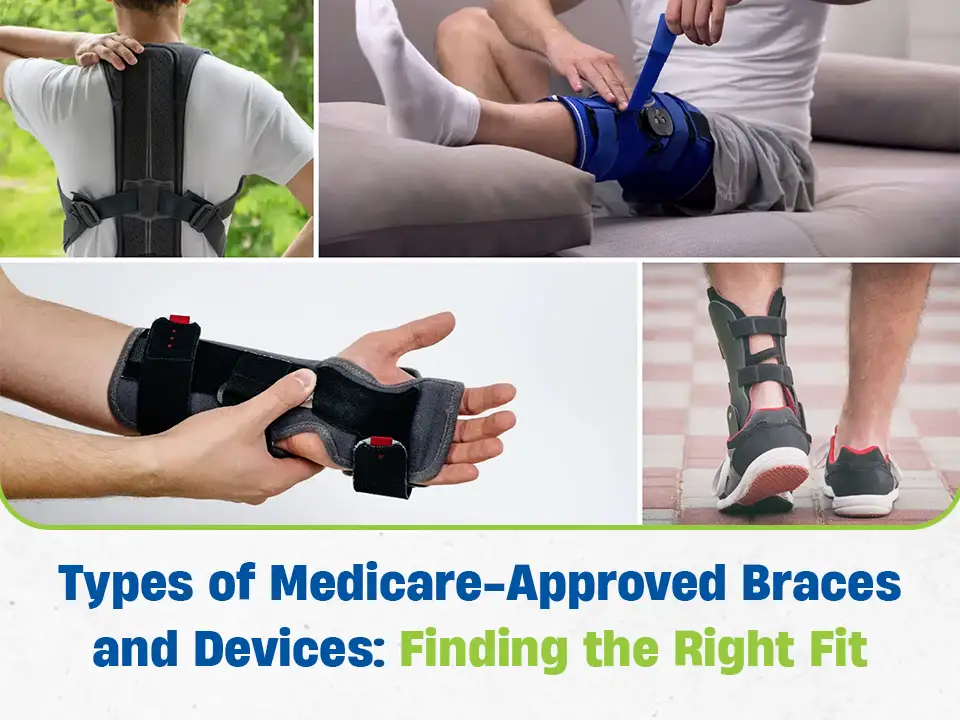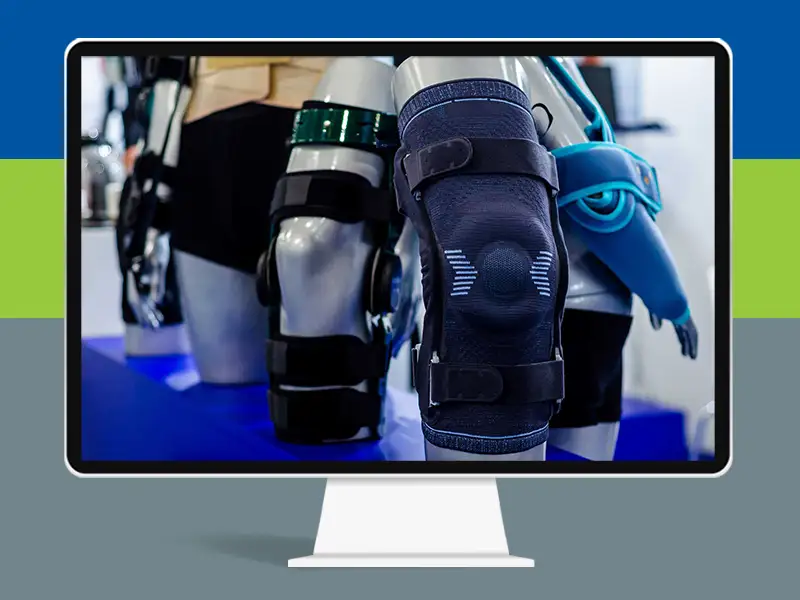Choosing the right Medicare-approved brace and device can be overwhelming, given the many options available for various health needs. This article aims to simplify this process, offering insights into different types of braces and devices covered by Medicare. Whether recovering from an injury, managing a chronic condition, or needing post-surgical support, understanding Medicare’s coverage and selecting the appropriate device is crucial. Here, we guide you through understanding the different braces and devices available, helping you make an informed choice for your health and well-being.
Understanding Medicare-Approved Braces and Devices
Medicare covers a variety of braces and orthotic devices under Part B as Durable Medical Equipment (DME). These items are crucial for physical support, pain relief, and the healing process for various medical conditions. To qualify for Medicare coverage, these braces and devices must be medically necessary, prescribed by a Medicare-enrolled physician, and sourced from a Medicare-approved supplier. This coverage is essential for patients needing such medical aids, whether for post-surgical recovery, chronic ailments, or mobility assistance, ensuring access to necessary support with manageable costs.
Exploring Types of Medicare-Approved Braces and Devices
Medicare’s coverage extends to a range of braces, each designed to target specific areas of the body:
- Back Braces: These braces are indispensable for individuals requiring spinal support. They are commonly prescribed for conditions like scoliosis herniated discs and for recuperation after spinal surgery. Back braces assist in maintaining correct spinal alignment, significantly alleviating discomfort and facilitating healing.
- Knee Braces: These are designed to support and stabilize various knee-related issues. Particularly beneficial for those with arthritis, knee braces are also crucial for post-surgical rehabilitation or recovery from knee injuries. They aid in stabilizing the knee joint, ensuring controlled movement, and reducing the risk of further injury.
- Ankle Braces: Ideal for managing conditions such as ankle sprains, strains, or instabilities, ankle braces offer critical support to this joint. Stabilizing the ankle is key in preventing further injury and enhancing recovery, allowing for safer mobility and activity.
- Wrist Braces: Particularly effective for conditions like carpal tunnel syndrome, wrist fractures, or tendonitis, wrist braces provide essential stability to the wrist area. They minimize strain and stress on the wrist, aiding in healing and relieving pain and discomfort.
- Shoulder Braces: These braces are extensively used in recovery from various shoulder injuries, including dislocations or rotator cuff repairs. By limiting movement and providing necessary support, shoulder braces ensure a conducive environment for the injured area to heal effectively.
- Neck Braces: Crucial for individuals with neck injuries, cervical spine disorders, or post-surgery recovery needs, neck braces offer vital support. They assist in maintaining proper neck alignment, alleviating pain, and facilitating healing.
- Hip Braces: These are designed for individuals experiencing hip-related issues, including post-operative recovery from hip surgeries, hip dislocations, or arthritis in the hip joint. Hip braces support the hip area, reducing pain, stabilizing the joint, and aiding recovery.
- Elbow Braces: Elbow braces are crucial for those recovering from elbow injuries, surgeries, or conditions like tennis elbow or elbow arthritis. They help stabilize the elbow joint, reducing undue strain and pain and facilitating healing.
Each of these braces is designed with a specific purpose – to support and protect the targeted area effectively. Their role in recovery and managing musculoskeletal conditions is invaluable, making them essential in many treatment plans. By understanding the unique features and applications of each type of brace, individuals can make informed decisions about their healthcare needs under Medicare coverage.
Choosing the Appropriate Medicare-Approved Brace and Devices
Making the right choice in selecting a brace or device is pivotal for effective treatment and comfort. Here’s how to find the best fit for your needs:
- Assess Your Needs: Understanding your specific health condition or injury thoroughly. Different types of braces offer varied support levels and restrict mobility to different extents. For instance, a rigid brace might be ideal for severe injuries, while a more flexible brace could suffice for mild discomfort.
- Consult with Healthcare Providers: It’s important to consult healthcare providers, such as doctors or physical therapists, for their expert recommendations. They can guide you to the brace type that aligns with your medical needs, ensuring optimal support and recovery.
- Comfort and Fit: A brace should fit snugly yet comfortably. It must provide the necessary support without restricting circulation or causing discomfort. An ill-fitting brace can do more harm than good, so finding the right size and fit is crucial.
- Ease of Use: Consider how user-friendly the brace is. Its effectiveness might be compromised if it’s too complicated to put on, adjust, or take off. A brace that is easy to use will ensure consistent wear, which is essential for recovery.
- Quality and Durability: Investigate the materials and construction of the brace. High-quality, durable materials ensure the brace withstands regular use and maintains its structural integrity over time. This is especially important for braces used for extended periods or under strenuous conditions.
Considering these factors, you can choose the brace that best suits your medical needs and lifestyle, ensuring you benefit most from your Medicare coverage.
Navigating Medicare Coverage for Braces and Devices
Securing Medicare coverage for braces and devices requires understanding and meeting specific criteria. Here’s how you can smoothly navigate this process:
- Understand Medicare Requirements: It’s important first to understand what Medicare requires to cover Durable Medical Equipment (DME). Familiarizing yourself with these criteria helps you know what to expect and prepare accordingly.
- Obtaining a Physician’s Prescription: For Medicare to cover a brace or orthotic device, a prescription from a Medicare-enrolled physician is mandatory. This prescription should clearly state the medical necessity of the brace or device for your condition.
- Selecting a Medicare-Approved Supplier: Not all suppliers are enrolled in Medicare, and using an unapproved supplier can lead to coverage issues. Ensure that the supplier you choose for your brace or device is officially enrolled in Medicare. This facilitates coverage and assures you of the quality and legitimacy of the equipment provided.
By carefully following these steps, you can effectively work within the Medicare system to obtain the necessary brace or device, ensuring you receive the support you need for your health condition while maximizing your Medicare benefits.
Maintenance and Care of Braces and Devices
Taking good care of your Medicare-approved braces and devices is essential for maintaining their effectiveness and extending their lifespan. Here are some crucial maintenance and care tips:
- Regular Cleaning: Following the manufacturer’s cleaning instructions, keep your brace or device clean. This often involves gentle washing and air drying, but specific care might vary depending on the material and design.
- Inspection for Wear and Tear: Regularly inspect your brace or device for any signs of damage or wear. Look for frayed straps, loose fittings, or any deterioration in the material. Early detection of wear can prevent further damage and ensure the brace continues to provide the necessary support.
- Proper Storage: Store your brace or device in a safe, dry place when not in use. Avoid exposing it to direct sunlight or extreme temperatures, which can degrade materials over time.
- Timely Replacement: If you notice significant wear or the brace no longer fits properly, it may be time for a replacement. Check with your healthcare provider and Medicare about obtaining a new brace if needed.
Following these maintenance and care guidelines ensures that your brace or device remains in good condition, providing the support and stability you need for your health and mobility.
Maximizing Benefits: Making the Most of Your Medicare-Approved Braces and Devices
Understanding how to use your Medicare-approved braces and devices effectively can significantly enhance its benefits:
- Proper Usage: It’s crucial to use the brace as directed by your healthcare provider. This ensures that you get the maximum support and benefit from the device. For instance, wearing a back brace correctly can alleviate pain and aid in proper posture.
- Integrating with Other Therapies: Often, a brace or device is most effective with other treatments like physical therapy, exercise, or medication. Discuss with your healthcare provider how to best incorporate your brace into your overall treatment plan.
- Monitoring Progress: Regularly assess how the brace is affecting your condition. Are you experiencing less pain? Is your mobility improving? Keeping track of these changes can help you and your healthcare provider make informed decisions about ongoing use or adjustments.
Patient Education and Resources
Being well-informed about your condition and the use of braces and devices is key to successful treatment:
- Educational Materials: Take advantage of educational resources your healthcare provider or Medicare provides. These can include brochures, instructional videos, or online resources that explain how to use and care for your brace.
- Support Groups and Forums: Consider joining support groups or online forums where you can connect with others using similar braces or devices. These communities can offer practical advice, support, and tips based on real-life experiences.
- Continuous Learning: Stay updated on new developments or improvements in brace technology and Medicare coverage. Regular consultations with your healthcare provider can also provide you with the latest information about your condition and treatment.
By understanding the types of braces available, how to select the right one, and how to maximize their benefits, you can make informed decisions about your healthcare needs and make the most of your Medicare coverage.
Conclusion
Selecting the right Medicare-approved braces and devices is vital in managing your health. By understanding the types of braces available, assessing your specific needs, and navigating Medicare’s coverage criteria, you can find the ideal fit that supports your health and enhances your quality of life. Remember, the right brace can significantly aid your recovery and daily comfort.
Artik Medical Supply provides high-quality, long-lasting medical supplies. We focus on our client’s needs to find the right solution that aligns with their primary care doctors’ guidance for their rehabilitation process. Are you needing pain relief, recovering from an injury, or surgery? Connect with us today to check eligibility and see how we can help.









